The Intel SSD 540s (480GB) Review
by Billy Tallis on June 23, 2016 9:00 AM ESTRandom Read Performance
The random read test requests 4kB blocks and tests queue depths ranging from 1 to 32. The queue depth is doubled every three minutes, for a total test duration of 18 minutes. The test spans the entire drive, which is filled before the test starts. The primary score we report is an average of performances at queue depths 1, 2 and 4, as client usage typically consists mostly of low queue depth operations.
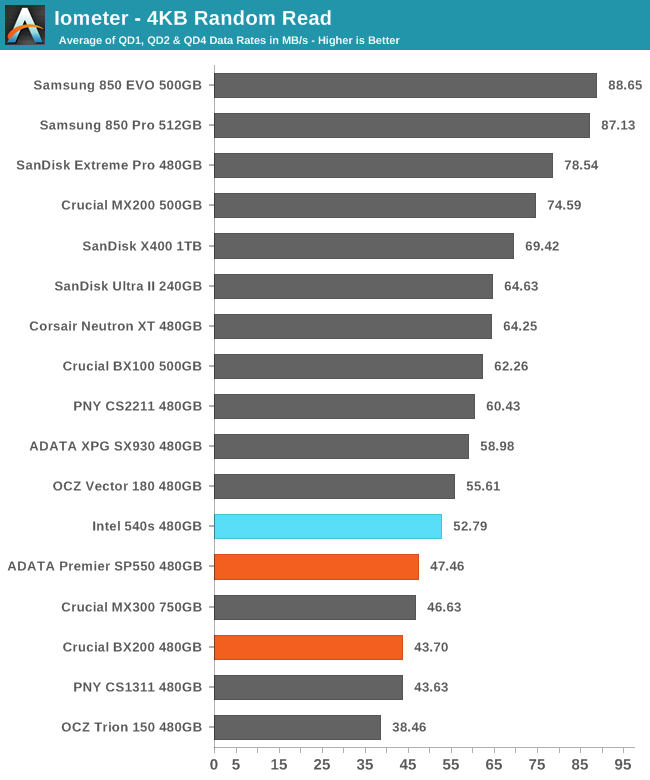
The random read speed of the Intel 540s is a significant improvement over both SM2256 drives and Phison S10 TLC drives, but isn't quite as fast as the MLC drives or SanDisk and Samsung TLC.
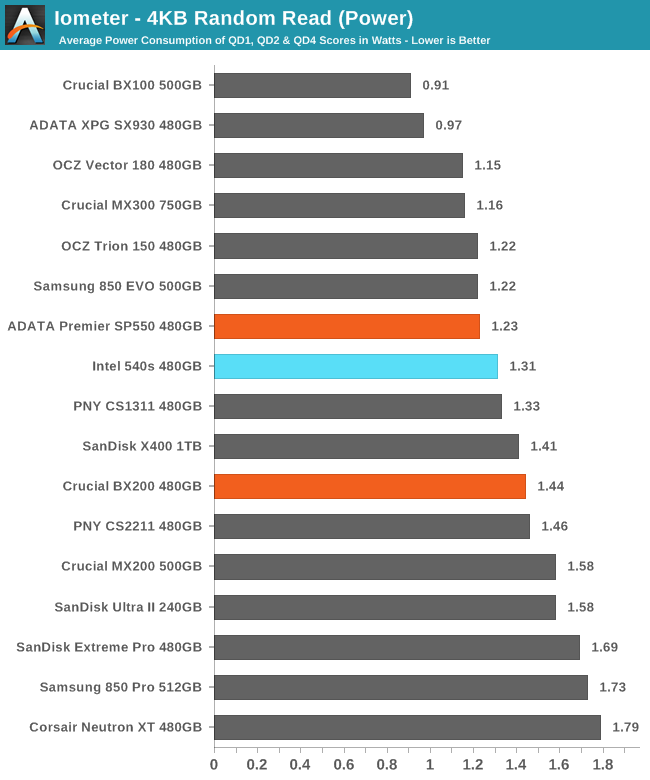
Power usage of the Intel 540s was slightly higher than the SP550, but given the performance increase their efficiency is similar and good overall.
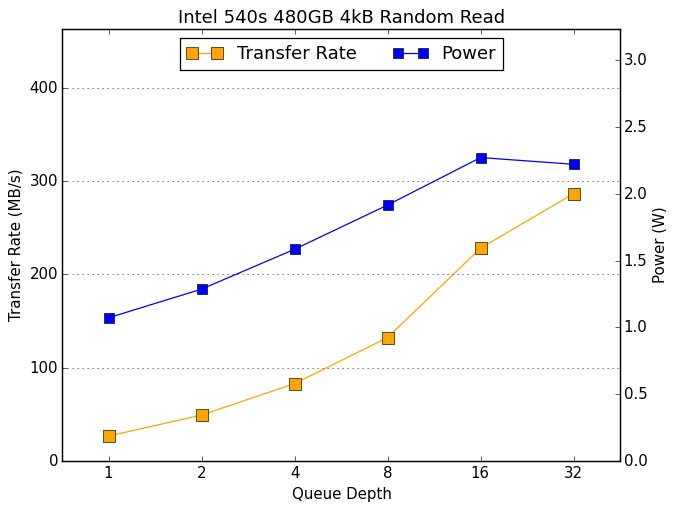 |
|||||||||
The Intel 540s drew more power and delivered more performance than the SP550 at every queue depth until QD32, where the SP550 performed slightly better.
Random Write Performance
The random write test writes 4kB blocks and tests queue depths ranging from 1 to 32. The queue depth is doubled every three minutes, for a total test duration of 18 minutes. The test is limited to a 16GB portion of the drive, and the drive is empty save for the 16GB test file. The primary score we report is an average of performances at queue depths 1, 2 and 4, as client usage typically consists mostly of low queue depth operations.
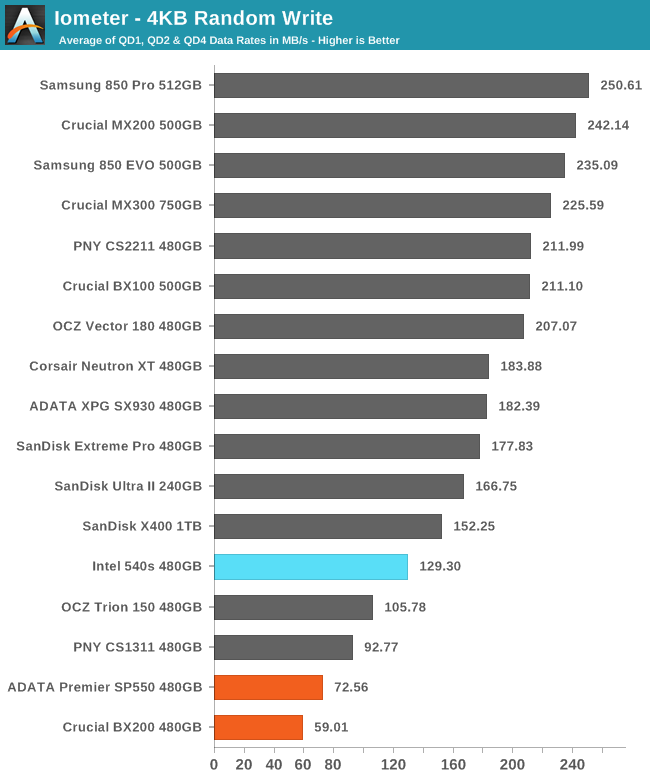
The Intel 540s shows almost double the performance on the random write test that the SM2256 drives did. This puts it well ahead of the Phison-based TLC drives and close to SanDisk's TLC drives.
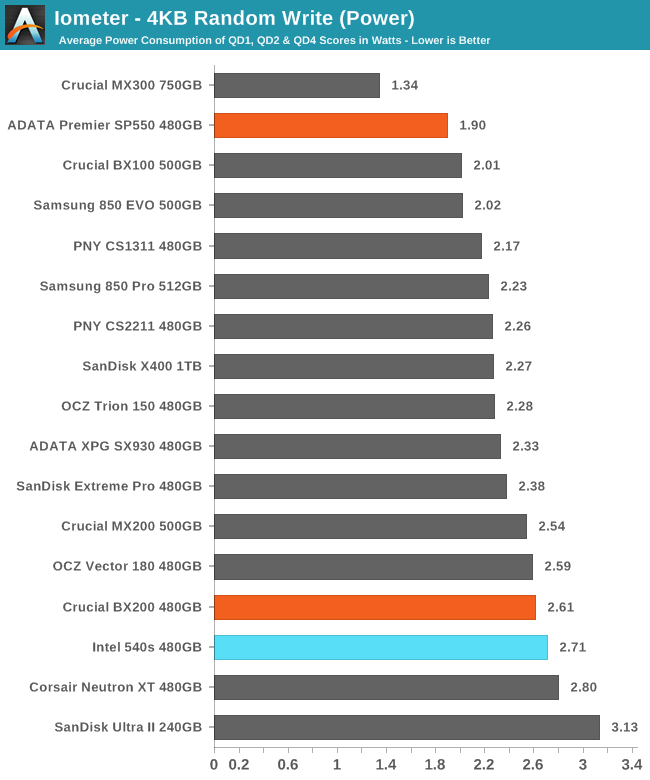
The Intel 540s had relatively high power draw during the random test, but it certainly wasn't the least efficient drive.
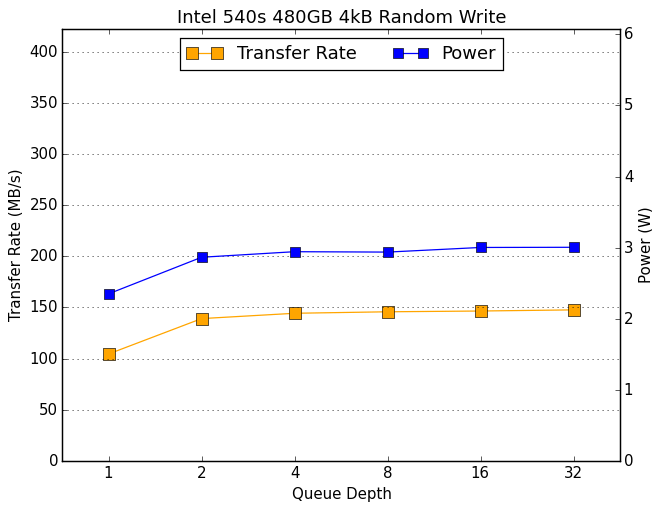 |
|||||||||
The random write performance of the Intel 540s increases moderately from QD1 to QD2 and only very slightly after that. The SM2256 drives started out slower and stayed there, though the BX200 drew more power with higher queue depths. Most budget TLC drives show relatively little scaling with queue depth here, with a few exceptions like the OCZ Trion 150 jumping up from QD4 and QD8.










77 Comments
View All Comments
Drasca - Tuesday, June 28, 2016 - link
There is a matter of scale. What is efficient for the small scale is not efficient for the large scale deployment.> even though it would probably save them a lot of dough
It wouldn't, it'd create the opposite effect costing them far more in the long run. You're thinking from the personal perspective where maintenence, reliability and security isn't an issue and non critical.
En mass, it costs them far more to have downtime, maintaining and replacing gear, than it does the initial purchase-- security notwithstanding either. They have to pay people time and money to keep the equipment up, whose price just snowballs as downtime accrues. The initial equipment cost is extremely fractional compared to the human resource cost of dealing with the equipment afterward, keeping track of it, security, physically replacing as it goes down, etc.
Buying from bulk also guarantees Hp/dell/lenovo has standardized problems and they replace the gear as it breaks wholesale. The equipment is closer to leased than purchased, with basically extended warranty guarantees. Consumer equipment does not have these protections and guarantees.
It costs far far far more in human resources spending time and money upkeeping a lot of gear that breaks, and all things will eventually break with this many pieces of equipment, taking up space that costs even more money, and causing a clusterfuck when you don't have government contracts.
The consumer level does not work at the government level and vice versa.
>entirely new workstation for that user.
They actually get entirely new workstations, for the most part. . . and old ones are worked to hell until budgets come in and approved for for upgrades across the board.
woggs - Thursday, June 23, 2016 - link
Intel doesn't ship unreliable drives (and will fix an issue if it slips out). That's the one thing you get from intel and is why they can get the big OEM orders. Other than that, I agree with "meh."trparky - Thursday, June 23, 2016 - link
For Christ's sake, why are we still using Planar NAND? Haven't we learned already that Flash memory at anything smaller than 19nm is just too unreliable? For God's sake! Everyone should be moving to 3D NAND already!trparky - Thursday, June 23, 2016 - link
Unless it's using 3D NAND, I won't buy it.ClockHound - Thursday, June 23, 2016 - link
3D? If it's not 4D, I'm not putting precious historically disposable data on it.chrcoluk - Sunday, July 17, 2016 - link
looks like its planar I am guessing by the small manufacturing size, one of the reasons ofr 3d nand is to use larger manufacturing process which has more reliable flash.16nm TLC is too scary for me.
euskalzabe - Friday, June 24, 2016 - link
Agreed. I was on the verge of buying a 512GB X400 but I think I'll wait until the fall, see what 3d NAND comes out...maxxbot - Thursday, June 23, 2016 - link
Who is this marketed for exactly? The X400 is faster AND cheaper, the 850 EVO is around the same price and much, much faster. It looks like you didn't even read the review.maxxbot - Thursday, June 23, 2016 - link
As for the reputable company comment, there's already a very reputable company out there that produces drives with much better price/performance: Samsung. Every corporate laptop I have had has had a Samsung SSD, why would they choose lower performance and higher price to go with this drive?alpha754293 - Monday, July 25, 2016 - link
Sadly though, my Intel 520 series SSDs performed better in random I/O (swapping) than this *NEW* Intel 540 series drive.The ONLY thing that has changed is cost. (I can buy a 1 TB 540 series drive at Microcenter for $250, and therefore; the $/GB has come down a LOT since the 520 series days), but for a 5-series drive, it certainly doesn't have the performance to match.
This was the same problem that I had with the 535 Series as well.
Whyyy would you release a NEW product that's actually inferior in measurable performance?
You would think that when you're buying a NEW drive, that you're getting the best that the company has to offer at this level. (Yes, I also have a 750 series PCIe x4 SSD as well, in case you were wondering (or not).)